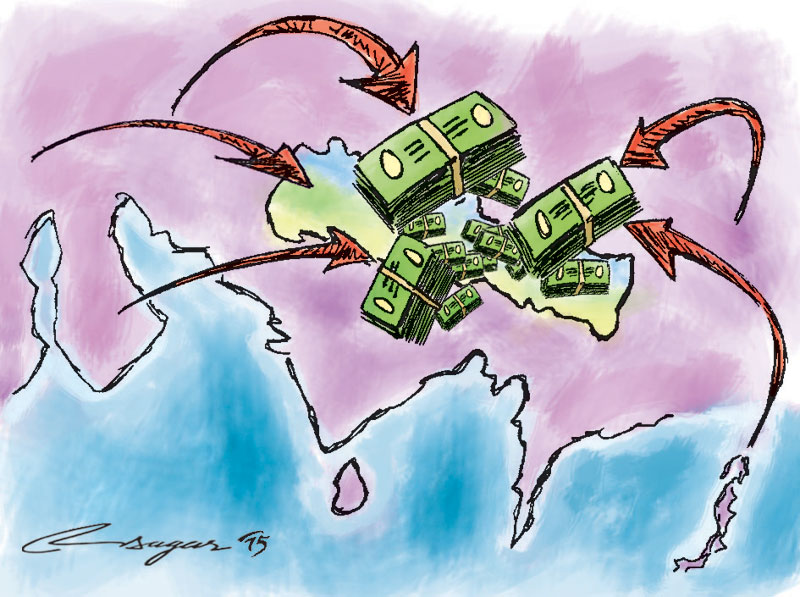Ease in remittance growth likely to pose downside risk
Slowdown in inflow of remittance exerted pressure on the current account and balance of payments in the first month (mid-July to mid-August) of this fiscal, 2016-17, shows the latest macroeconomic update of the central bank.
According to the report titled ‘Current Macroeconomic and Financial Situation of Nepal’ unveiled by Nepal Rastra Bank (NRB) today, workers’ remittances declined by 2.5 per cent to Rs 51.94 billion in the review period compared to a growth of 26.3 per cent in the corresponding period of the previous year.
Consequently, net transfer receipt decreased 2.5 per cent to Rs 59.79 billion in the review period. Such receipt had increased by 29.7 per cent in the same period of the previous year.
The report shows that the current account slipped into a deficit of Rs 2.32 billion in the review period on account of a decline in remittance and foreign grants, from a surplus of Rs 8.15 billion in the same period of the previous year.
Similarly, the overall balance of payments fell into negative territory at Rs 2.13 billion in the review period from a surplus of Rs 4.77 billion in the same period of the previous year.
“Anaemic growth in remittances is likely to pose downside risk to overall economic activities in general and the service industry in particular,” the NRB report has stated.
Between mid-July to mid-August, merchandise exports increased 7.7 per cent to Rs 6.96 billion compared to a drop of 3.9 per cent in the same period of the previous year. In the review period, exports to India, China and other countries increased 0.8 per cent, 58.5 per cent and 16.1 per cent, respectively.
Merchandise imports increased by 13 per cent to Rs 70.72 billion in the review period compared to a growth of 7.2 per cent in the same period of the previous year. In the first month of the fiscal, imports from India, China and other countries increased 9.5 per cent, 10.5 per cent and 26.2 per cent, respectively.
With the rise in imports exceeding the growth in exports, the total trade deficit in the review period widened 13.6 per cent to Rs 63.76 billion compared to an expansion of 8.7 per cent in the same period of the previous year.
The export-import ratio fell to 9.8 per cent in the review period from 10.3 per cent in the corresponding period of the previous year.
Meanwhile, the gross foreign exchange reserves stood at Rs 1,041.97 billion as of mid-August, an increase of 0.3 per cent from Rs 1,039.21 billion in mid-July. Based on the imports of the first month of current fiscal year, the foreign exchange holdings of the banking sector are sufficient to cover the prospective merchandise imports of 15.1 months, and merchandise and services imports of 12.7 months, the report says.
On a positive note, increased government capital expenditure along with the emphasis on reconstruction related works and the disbursement of grants for rebuilding of houses destroyed by the earthquake of 2015 are expected to boost rural activities. The favourable monsoon is expected to support agricultural production this year. In addition, timely availability of chemical fertilisers and insecticides, and the containment of spread of epidemic diseases and insects in the standing crops is expected to have a positive impact on the agriculture sector
However, the tourism sector, which was hit by the earthquakes along with the strikes and blockades of the previous year, has still to recover fully. According to the Hotel Association Nepal, the bed occupancy rate in tourist standard hotels is estimated to be around 30 per cent in review period.
Inflation eases to 8.6pc
KATHMANDU: The consumer price inflation eased to 8.6 per cent in mid-August from 10.4 per cent in mid-July, shows the macroeconomic report of Nepal Rastra Bank unveiled on Thursday. A year ago, consumer inflation was 6.9 per cent. The higher rate of increase in prices of sugar and sugar products, pulses and legumes, vegetables, fruits, miscellaneous goods and services, clothes and footwear, housing and utilities exerted an upward pressure on the overall consumer price inflation in the review period compared to that of last year.






